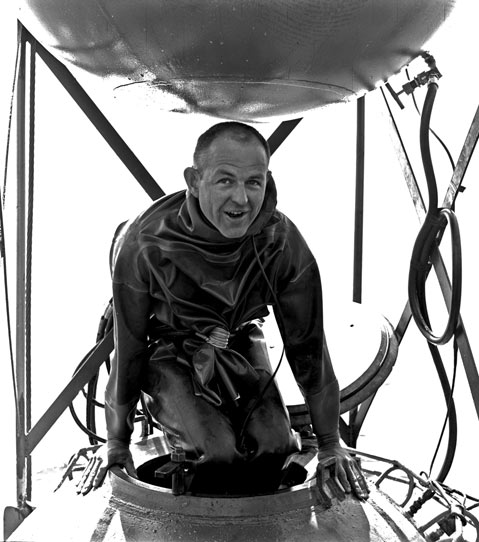I first met Bob in 1989, when I was hired by Santa Barbara City College to teach in the Marine Technology Department, a program Bob had been instrumental in setting up. Even though he had recently retired from the college after 16 years of teaching, he took an interest in me, and I drew upon him as a resource for over 25 years.
Coming straight from the commercial diving industry, I knew little about formal education, and some of my students may tell you that, 25 years later, I still don’t. But my good friend and colleague at SBCC Mike Von Alvensleben mentored me in my early years and helped me build a teaching identity. Mike taught me many things back then that have stayed with me to this day.
I soon found out that Mike was mentored in a similar way by Bob Christensen, which is the way we do things at Marine Tech. Bob had hired Mike back in 1982, and the two of them continued to work together with Kirby Morgan Dive Systems long after their SBCC days.

A friend and mentor to many throughout his career, Bob was widely regarded by commercial, recreational, and military divers alike; he always shared his knowledge and expertise for the benefit of others. Up until this past year, Bob continued to participate in SBCC diving outings with our aspiring young divers. His mere presence was a priceless addition.
Bob once told me that the secret to instruction is to coach and not teach: “Create the situations where students can discover things on their own and build a structure from real experiences.” His approach was anything but instructor-centered. He was years ahead of contemporary educators.
Once I got to know Bob, I quickly discovered that this was a man who knew both diving and education, yet I had no idea of how accomplished he was in so many other areas. As I became involved with the Santa Barbara Maritime Museum, I learned more and more about him. He would never tell you about what he did — you had to ask. Bob’s contributions to our industry are documented forever in Chris Swann’s book The History of Oilfield Diving.
Bob was one of the early pioneers of deep mixed-gas commercial diving, which evolved in Santa Barbara in the early 1960s. These innovators were sometimes referred to as “underwater cowboys” due to their risk-taking nature in reaching new depths in support of offshore exploration operations. Bob Christensen, however, was anything but that. He was meticulous in his preparation and work, joining other Santa Barbarans, including Dan Wilson, Lad Handelman, Bev Morgan, Bob Kirby, Whitey Stefens, Bob and Ted Benton, and Bob Ratcliffe, to establish Santa Barbara as the birthplace of deepwater mixed-gas diving. The diving industry became safer and more prosperous due to the efforts of Bob Christensen and these men.
Bob was one of the original test divers of the world’s first commercial lockout diving bell — the Purisima diving bell — which was launched out of Santa Barbara Harbor in 1964 and is now displayed at the Maritime Museum. He later was a test diver for Union Carbide in Tonawanda, N.Y., for deep experimental mixed-gas dives.
In 1969, he left the booming deepwater commercial diving field to help establish SBCC’s Marine Technology Program as one of the original tenured instructors. He succeeded the late Ramsey Parks as program director from 1980-1985 and then retired.
Bob helped design and improve most of the modern-day commercial diving gear used in the industry today. Along with Kirby Morgan, he also helped design several of the functional diving helmets used on Hollywood movie sets.
What is most impressive about Bob is that he was so humble and uncomplicated. There was no BS with Bob. When he spoke, he spoke the truth.
After graduating from Santa Barbara High School, Bob received his undergraduate degree from USC and then served in the U.S. Navy. He added to his diving experience by attending Navy Dive School. He was a member of the elite Underwater Demolition Team 11, which is now the U.S. Navy SEAL Team. Additionally, Bob was a father, husband, grandfather, great-grandfather, and, most importantly — a true gentleman.
Another well-known Santa Barbara diving pioneer, Lad Handelman, wrote:
“By his sheer presence, on the job or off the job, Christensen made us want to be better men. When he was in the mix, we wanted to perform better and act better — our image got better — and thus the reputation of our emerging industry got better.
“Many of us made contributions, inventions, technology, and so forth. Bob Christensen brought intangibles.
“He brought integrity, quality workmanship, and the purest of fellowship. I know of not a single human being who did not like and respect him.”
Don Barthelmess is currently a professor in the Marine Technology Program at SBCC. He was honored as SBCC’s Annual Faculty Lecturer in 2008 and dedicated his award to Bob Christensen, creating a scholarship in his honor. To contribute, visit [links lost] Christensen Memorial Scholarship Fund, c/o Don Barthelmess SBCC MDT, 721 Cliff Drive, Santa Barbara, CA 93109.
